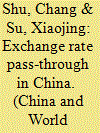|
|
|
Sort Order |
|
|
|
Items / Page
|
|
|
|
|
|
|
| Srl | Item |
| 1 |
ID:
086474


|
|
|
|
|
| Publication |
2009.
|
| Summary/Abstract |
During the second half of 2007 and early part of 2008 when there were intense inflationary pressures in China, RMB appreciation was advocated as a means of helping to curb inflation. The effectiveness of appreciation in controlling inflation depends on the impact of exchange rate movements on import and domestic prices. Our analysis finds fairly large and speedy exchange rate pass-through (ERPT) to import prices: 50 and 60 percent for the short run and long run, respectively. However, the degree of ERPT decreases along the price chain from upstream to downstream prices. ERPT for consumer prices, the most downstream prices, is much milder and has substantial lags. A 10-percent rise in the nominal effective exchange rate will dampen consumer prices by 1.1 percent within a year, with very little pass-through in the first half year, and by 2.0 percent over the long run. These findings, particularly the ERPT to consumer prices, suggest that RMB appreciation can help to reduce inflationary pressures over the longer term. However, it is unlikely to provide rapid relief to the current round of high inflation because of the long lags in ERPT. The RMB needs to strengthen in effective terms to exert the desired dampening impact on prices.
|
|
|
|
|
|
|
|
|
|
|
|
|
|
|
|
| 2 |
ID:
143440


|
|
|
|
|
| Summary/Abstract |
This study presents evidence of the renminbi's growing influence in the Asia-Pacific region. The CNH market – the offshore renminbi foreign exchange market – is found to exert an effect on Asian currencies that is distinct from that of the onshore (CNY) market. Changes in the RMB/USD rates in both markets have a statistically and economically significant impact on changes in Asian currency rates against the US dollar, after controlling for other major currency moves and the transmission of China's monetary policy to the region. The continuing growth of the offshore renminbi market points to rising influence of the CNH market, but how long the independent impact will last will likely depend on China's progress in liberalising its capital account. The findings also suggest that China's regional influence is increasingly transmitted through financial channels.
|
|
|
|
|
|
|
|
|
|
|
|
|
|
|
|
| 3 |
ID:
079059


|
|
|
|
|
| Publication |
2007.
|
| Summary/Abstract |
This study reviews the developments in the onshore and offshore renminbi derivatives markets. The onshore market has seen a rapid build-up in the market infrastructure and price discovery mechanism in the past year, with empirical evidence suggesting that its pricing is increasingly determined by financial fundamentals, such as the covered interest rate parity. However, the growth of the market has been restrained by restrictions on the participant base, limited variations in the RMB/US$ exchange rate, market participants'lack of technical capacity and experience, and inadequate supporting financial market infrastructure. The non-deliverable forward (NDF) market, concentrated in Hong Kong and Singapore, is more developed, but has the drawback that its pricing is not tied to financial fundamentals. The comparison between onshore and offshore markets suggests that two issues are of particular importance for future derivatives market development in China: the balance between regulation and development, and the relationship between onshore and offshore markets.
|
|
|
|
|
|
|
|
|
|
|
|
|
|
|
|
|
|
|
|
|